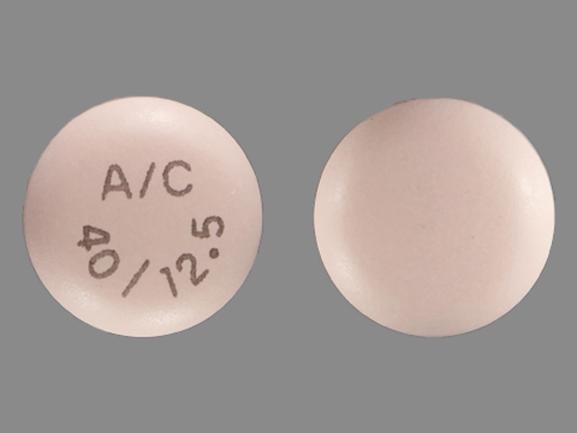Edarbyclor Side Effects
Generic name: azilsartan medoxomil / chlorthalidone
Medically reviewed by Drugs.com. Last updated on Sep 17, 2023.
Note: This document contains side effect information about azilsartan medoxomil / chlorthalidone. Some dosage forms listed on this page may not apply to the brand name Edarbyclor.
Applies to azilsartan medoxomil / chlorthalidone: oral tablet.
Warning
Oral route (Tablet)
Discontinue use of azilsartan medoxomil/chlorthalidone as quickly as possible if pregnancy is detected, as drugs that act directly on the renin-angiotensin system can cause injury and death to the developing fetus.
Serious side effects of Edarbyclor
Along with its needed effects, azilsartan medoxomil / chlorthalidone may cause some unwanted effects. Although not all of these side effects may occur, if they do occur they may need medical attention.
Check with your doctor immediately if any of the following side effects occur while taking azilsartan medoxomil / chlorthalidone:
Less common
- Blurred vision
- confusion
- convulsions
- decreased urine
- dizziness, faintness, or lightheadedness when getting up suddenly from a lying or sitting position
- dry mouth
- fainting
- increased thirst
- irregular heartbeat
- loss of appetite
- muscle pain or cramps
- nausea or vomiting
- numbness or tingling in the hands, feet, or lips
- shortness of breath
- sweating
- unusual tiredness or weakness
Incidence not known
- Ankle, knee, or great toe joint pain
- joint stiffness or swelling
- lower back, side, or stomach pain
- swelling of the feet or lower legs
Other side effects of Edarbyclor
Some side effects of azilsartan medoxomil / chlorthalidone may occur that usually do not need medical attention. These side effects may go away during treatment as your body adjusts to the medicine. Also, your health care professional may be able to tell you about ways to prevent or reduce some of these side effects.
Check with your health care professional if any of the following side effects continue or are bothersome or if you have any questions about them:
More common
- Dizziness
Rare
- Cough
- diarrhea
- lack or loss of strength
- muscle spasm
Incidence not known
For Healthcare Professionals
Applies to azilsartan medoxomil / chlorthalidone: oral tablet.
General
The most common side effects were dizziness and fatigue.[Ref]
Nervous system
Common (1% to 10%): Dizziness
Uncommon (0.1% to 1%): Syncope
Postmarketing reports: Loss of consciousness
Azilsartan:
Common (1% to 10%): Dizziness
Frequency not reported: Dizziness postural
Chlorthalidone:
Common (1% to 10%): Dizziness
Frequency not reported: Headache[Ref]
Other
Common (1% to 10%): Fatigue
Azilsartan:
Uncommon (0.1% to 1%): Fatigue
Frequency not reported: Asthenia
Chlorthalidone:
Common (1% to 10%): Fatigue[Ref]
Renal
Common (1% to 10%): Consecutive creatinine increases of 50% or greater from baseline and greater than the upper limit of normal
Azilsartan:
Uncommon (0.1% to 1%): Consecutive creatinine increases of 50% or greater from baseline and greater than the upper limit of normal
Chlorthalidone:
Uncommon (0.1% to 1%): Consecutive creatinine increases of 50% or greater from baseline and greater than the upper limit of normal[Ref]
Gastrointestinal
Postmarketing reports: Nausea
Azilsartan:
Frequency not reported: Diarrhea, nausea
Chlorthalidone:
Frequency not reported: Gastrointestinal upset[Ref]
Cardiovascular
Common (1% to 10%): Hypotension[Ref]
Dermatologic
Postmarketing reports: Rash, pruritus, angioedema
Chlorthalidone:
Frequency not reported: Rash[Ref]
Hepatic
Chlorthalidone:
Frequency not reported: Cholesterol elevated[Ref]
Metabolic
Frequency not reported: BUN increased
Chlorthalidone:
Frequency not reported: Uric acid elevated[Ref]
Musculoskeletal
Azilsartan:
Frequency not reported: Muscle spasm[Ref]
Respiratory
Azilsartan:
Frequency not reported: Cough[Ref]
More about Edarbyclor (azilsartan medoxomil / chlorthalidone)
- Check interactions
- Compare alternatives
- Pricing & coupons
- Reviews (26)
- Drug images
- Dosage information
- During pregnancy
- FDA approval history
- Drug class: angiotensin II inhibitors with thiazides
- En español
Patient resources
Professional resources
Related treatment guides
References
1. Product Information. Edarbyclor (azilsartan-chlorthalidone). Takeda Pharmaceuticals America. 2012.
Further information
Always consult your healthcare provider to ensure the information displayed on this page applies to your personal circumstances.
Some side effects may not be reported. You may report them to the FDA.

